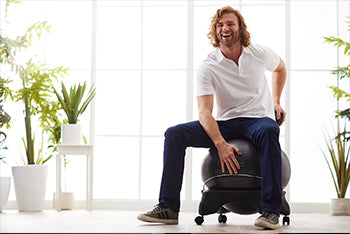Bringing Your Mobility Back: Why Functional Movement is Important

Staying active is important - we all know that we need to move our bodies consistently to stay healthy and live a happy life. Many of us run, bike, do Crossfit, practice yoga or any number of other activities. We also all tend to sit or stand for long periods of time, whether it’s at a desk job in front of a computer, standing behind a counter, or commuting in the car - just to name a few.
This means that we spend the majority of our waking time in one plane of movement - a forward pattern. This means our shoulders are forward, hips internally rotated and slight flexion or forward-bending in the spine. But this isn’t necessarily true in just our work and home lives, but in many of our physical activities and modes of exercise too. Running, walking, and biking all happen in the same plane as well, therefore adding mobility exercises into our routine is crucial to developing more range of motion in the body.
Mobility utilizes joint pattern movement in all ranges of motion. By being intentional about the movements you work into the body you can regain, and improve, your range of motion. As we age and live our lives in the same routines, our muscles, ligaments, and joints get used to those patterns. The elasticity in our muscles change and the synovial fluid in our joints decrease, therefore the range of motion in our joints change depending on our movement, or lack thereof it.
So how do we get that mobility back? Functional movement takes your joints through their full range of motion and engages the stabilizing muscles. This is important in preventing injury and bringing efficient and healthy movement back to the body. The seven general movement patterns of the body are squat, lunge, push, pull, hinge, twist, and walk. Looking at each of these movements from a standpoint of stability and range of motion will help you regain lost movement. The other piece of this puzzle is adding in some form of myofascial release. This can be in the form of foam rolling.
Foam rolling helps to break up knots or adhesions in the muscle and resume normal blood flow and function. Using a good foam roller, like Gaiam's Deep Tissue or Muscle Therapy versions will make a big difference. You can also add in some form of trigger point therapy to help reduce pain or inflammation in the body. Combining these practices creates a routine of active recovery - pairing that with yoga or other low-intensity exercise will help to start breaking your body of the patterns of movement you have built up over years and years.
Like anything else, a mobility routine only makes a difference if you do it consistently and stick to it. If you’ve been working a desk job for 10, 20, or 30 years, it will take some time to break your body of that habit. The same is true of physical activities. If you have cycled for years as your main form of exercise, it will take time to create flexibility and mobility in your leg muscles and joints as well as in your upper back and shoulders.
The easiest way to think about the movements you should be adding into your routine is to find those ranges of motion that are the opposite of what you do most frequently. The majority of us need to explore external hip rotation, extension and lateral bending in the spine, and shoulder and chest opening. There are many movements the body can benefit from and part of this process is just exploring!
Clarissa is a E-RYT® 200, RYT® 500, YACEP® teaching since 2014 and practicing since 2007. She travels presenting at festivals, conferences, & leading retreats through Light The Spark Within Retreats. Their next retreat is Greece 2019! Clarissa teaches Vinyasa style classes with some Ashtanga influence and enjoys creating a variety of workshops and courses. She has had a dedicated Ashtanga practice for over 5 years that has fueled her desire to learn and share the power of yoga with as many people as she can! She has also worked with athletes and people of all ranges of motion and believes in the power of movement. She has developed a fully online mobility program which can be found on her website: http://clarissamae.com/mobility-program/
Clarissa lives in Spearfish, South Dakota with her husband Wade and their pup Inkling.
Also in Blog

Body Peace & Personal Empowerment

Yoga for Swimmers: Poses for Strength and Mobility







